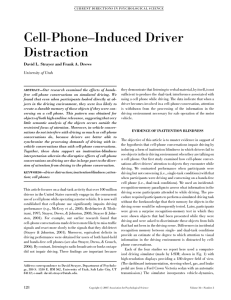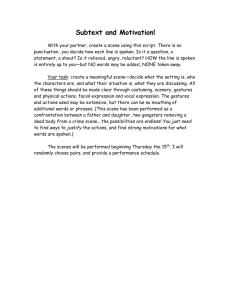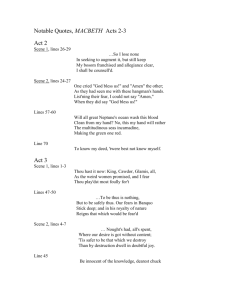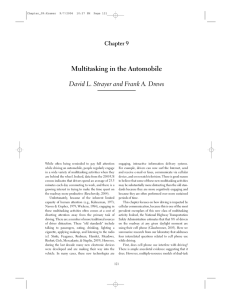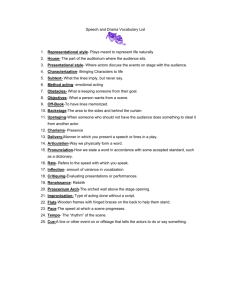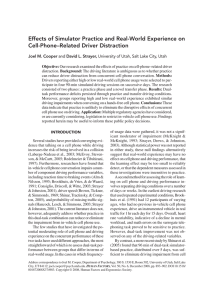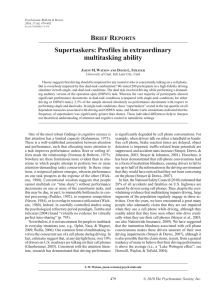What do drivers fail to see when conversing
advertisement
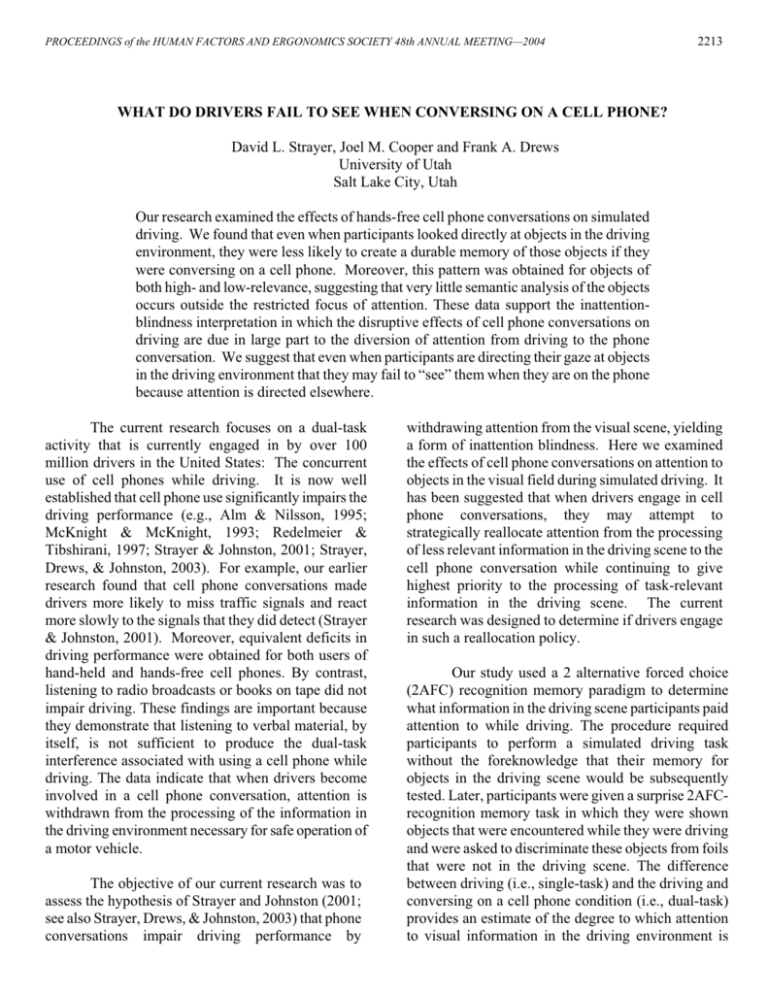
PROCEEDINGS of the HUMAN FACTORS AND ERGONOMICS SOCIETY 48th ANNUAL MEETING—2004 2213 WHAT DO DRIVERS FAIL TO SEE WHEN CONVERSING ON A CELL PHONE? David L. Strayer, Joel M. Cooper and Frank A. Drews University of Utah Salt Lake City, Utah Our research examined the effects of hands-free cell phone conversations on simulated driving. We found that even when participants looked directly at objects in the driving environment, they were less likely to create a durable memory of those objects if they were conversing on a cell phone. Moreover, this pattern was obtained for objects of both high- and low-relevance, suggesting that very little semantic analysis of the objects occurs outside the restricted focus of attention. These data support the inattentionblindness interpretation in which the disruptive effects of cell phone conversations on driving are due in large part to the diversion of attention from driving to the phone conversation. We suggest that even when participants are directing their gaze at objects in the driving environment that they may fail to “see” them when they are on the phone because attention is directed elsewhere. The current research focuses on a dual-task activity that is currently engaged in by over 100 million drivers in the United States: The concurrent use of cell phones while driving. It is now well established that cell phone use significantly impairs the driving performance (e.g., Alm & Nilsson, 1995; McKnight & McKnight, 1993; Redelmeier & Tibshirani, 1997; Strayer & Johnston, 2001; Strayer, Drews, & Johnston, 2003). For example, our earlier research found that cell phone conversations made drivers more likely to miss traffic signals and react more slowly to the signals that they did detect (Strayer & Johnston, 2001). Moreover, equivalent deficits in driving performance were obtained for both users of hand-held and hands-free cell phones. By contrast, listening to radio broadcasts or books on tape did not impair driving. These findings are important because they demonstrate that listening to verbal material, by itself, is not sufficient to produce the dual-task interference associated with using a cell phone while driving. The data indicate that when drivers become involved in a cell phone conversation, attention is withdrawn from the processing of the information in the driving environment necessary for safe operation of a motor vehicle. The objective of our current research was to assess the hypothesis of Strayer and Johnston (2001; see also Strayer, Drews, & Johnston, 2003) that phone conversations impair driving performance by withdrawing attention from the visual scene, yielding a form of inattention blindness. Here we examined the effects of cell phone conversations on attention to objects in the visual field during simulated driving. It has been suggested that when drivers engage in cell phone conversations, they may attempt to strategically reallocate attention from the processing of less relevant information in the driving scene to the cell phone conversation while continuing to give highest priority to the processing of task-relevant information in the driving scene. The current research was designed to determine if drivers engage in such a reallocation policy. Our study used a 2 alternative forced choice (2AFC) recognition memory paradigm to determine what information in the driving scene participants paid attention to while driving. The procedure required participants to perform a simulated driving task without the foreknowledge that their memory for objects in the driving scene would be subsequently tested. Later, participants were given a surprise 2AFCrecognition memory task in which they were shown objects that were encountered while they were driving and were asked to discriminate these objects from foils that were not in the driving scene. The difference between driving (i.e., single-task) and the driving and conversing on a cell phone condition (i.e., dual-task) provides an estimate of the degree to which attention to visual information in the driving environment is PROCEEDINGS of the HUMAN FACTORS AND ERGONOMICS SOCIETY 48th ANNUAL MEETING—2004 distracted by cell phone conversations. Method Participants. Sixty-four undergraduates from the University of Utah participated in the experiment. All had normal or corrected-to-normal vision and a valid drivers’ license. Stimuli and Apparatus. A PatrolSim highfidelity fixed-base driving simulator, manufactured by GE I-Sim (www.i-sim.com) and illustrated in Figure 1, was used in the study. The simulator incorporated proprietary vehicle dynamics, traffic scenario, and road surface software to provide realistic scenes and traffic conditions. The dashboard instrumentation, steering wheel, gas, and brake pedal were taken from a Ford Crown Victoria® sedan with an automatic transmission. Figure 1. A participant talking on a cell phone while driving in the simulator. The key manipulation in the study was the placement of 30 objects (e.g., cars, trucks, pedestrians, signs, billboards, etc.) along the roadway in the driving scene. Another 30 objects were not presented in the driving scene and served as foils in the 2AFCrecognition memory task. The objects were counterbalanced across participants so that each was used equally often as a target and as a foil. Objects in the driving scene were positioned so that they were clearly in view as participants drove past them. Eye movement data were recorded from 32 of the participants using an Applied Science Laboratories 2214 (ASL) eye and head tracker (Model 501). The ASL mobile 501 eye-tracker is a video-based unit that allows free range of head and eye movements, thereby affording naturalistic viewing conditions for the participants as they negotiated the driving environment. Procedure. When participants arrived for the experiment, they completed a questionnaire that assessed their interest in potential topics of cell phone conversation. Participants were then familiarized with the driving simulator using a standardized 20 minute adaptation sequence. The experiment involved driving two 7-mile sections of an urban highway. One of the scenarios was used in the single-task (i.e., driving only) condition and the other was used in the dual-task (i.e., driving and conversing on a cell phone) condition. The order of single-task and dual-task conditions and driving scenario were counterbalanced across participants. The participant’s task was to drive through each scenario, following all the rules of the road. The dual-task condition involved conversing on a cell phone with a research assistant. The participant and the research assistant discussed topics that were identified in the pre-experiment questionnaire as being of interest to the participant. To avoid any possible interference from manual components of cell phone use, participants used a hands-free cell phone that was positioned and adjusted before driving began. Additionally, the call was initiated before participants began the dual-task scenarios. Thus, any dual-task interference that we observe must be due to the cell phone conversation itself, because there was no manual manipulation of the cell phone during the dualtask portions of the study. Immediately following the driving portion of the study, participants performed a 2AFC-recognition memory task in which they attempted to identify which objects had been presented in the driving scenario. On each trial, two objects were presented on a computer display and remained in view until participants made their judgment (i.e., which of the two objects did they see while driving in the simulator?). After the forced choice judgment, participants were also asked to rate the two objects in terms of their relevance to safe 2215 PROCEEDINGS of the HUMAN FACTORS AND ERGONOMICS SOCIETY 48th ANNUAL MEETING—2004 Analysis. Eye-tracking data from 32 participants were analyzed to determine whether or not the participant fixated on each object. We required the participant’s eyes to be directed at the center of the object for at least 100 msec for the object to be classified as having been fixated. The 100 msec criterion ensured that the image had stabilized on the participant’s retinae. Results and Discussion Objects presented in single-task conditions were correctly recognized more often than objects from dual-task conditions, F(1,63)=5.80, p<.05. Corrected for guessing mean recognition probability for the single-task conditions was 0.21 (sd=0.14) and for the dual-task condition was 0.16 (sd=0.11). These data are consistent with the hypothesis that the cell phone conversation disrupts performance by diverting attention from the external environment associated with the driving task to an engaging internal context associated with the cell phone conversation. We next assessed whether the differences in recognition memory may be due to differences in eye fixations on objects in the driving scene. The eyetracking data indicated that participants fixated on approximately 61% of the objects in the driving scene. The difference in the probability of fixating on objects from single- to dual-task conditions was not significant, F(1,31)=0.78, p> .40. Thus, the contribution of fixation probability on recognition memory performance would appear to be minimal. We also measured total fixation duration in single- and dual-task conditions to ensure that the observed differences in recognition memory were not due to longer fixation times in single-task conditions. There was a tendency for recognition probability to increase with fixation duration (r = 0.14); however, the difference in fixation duration between single- and dual-task conditions was not significant, F(1,31)=1.63, p>.16. As above, the differences in recognition memory performance that we observed in single- and dual-task conditions does not appear to be due to alterations in visual scanning of the driving environment. We also computed the conditional probability of recognizing an object given that participants fixated on it while driving. This analysis is important because it specifically tests for memory of objects that were presented where the driver’s eyes were directed. The corrected for guessing conditional probability analysis revealed that participants were more likely to recognize objects presented in the single-task condition (mean=0.25, sd=.15) than in the dual-task condition (mean=0.15, sd=.19), F(1,31)=5.28, p<.05. Note that dual-task performance was 60% of that obtained in single-task conditions. Estimates of effects size (Cohen’s d = 0.58) indicate that this is a medium sized effect. Thus, when we ensured that participants fixated on an object, we found significant differences in recognition memory between single- and dual-task conditions. Driving Safety Relevance Ratings 9 8 Average Relevance Rating driving using a 10 point scale (participants were given an example in which a child playing near the road might receive a rating of 9 or 10, whereas a sign documenting that a volunteer group cleans a particular section of the highway might receive a rating of 1). There was no relationship between the order of presentation of the objects in the driving task and the order of presentation in the 2AFC-recognition memory task. Participants were not informed about the memory test until after they had completed the driving portions of the experiment. 7 6 5 4 3 2 1 0 0 10 20 30 40 50 60 Objects Figure 2. Average safety relevance ratings for the objects used in the study. Ratings ranged between 1.5 and 8.0, with an overall average of 4.1 on a 10 point scale. Our final analysis focused on participant’s rating of each item’s relevance in the driving scene in PROCEEDINGS of the HUMAN FACTORS AND ERGONOMICS SOCIETY 48th ANNUAL MEETING—2004 terms of traffic safety. As illustrated in Figure 2, item relevance ratings ranged from 1.5 to 8. The overall rating of traffic relevance was 4.1 (sd=1.0). As would be expected given the counterbalancing procedures, the difference in the rating of traffic relevance from single- to dual-task conditions was not significant, F(1,31)=0.93, p> .37. We conducted a series of regression analyses to determine the extent to which driving relevance affected recognition memory performance in single- and dual-task conditions. The correlation between recognition memory performance and traffic relevance was not significant (r = .03) and remained unchanged when the variance associated with single- and dual-task conditions was partialed out. That is, traffic relevance had absolutely no effect on the difference in recognition memory between singleand dual-task conditions. This analysis is important because it demonstrates that participants did not strategically reallocate attention from the processing of less relevant information in the driving scene to the cell phone conversation while continuing to give highest priority to the processing of task-relevant information in the driving scene. In fact, the contribution of an object’s perceived relevance to safe driving on recognition memory performance would appear to be negligible. Conclusions The results indicate that conversing on a cellular phone disrupts the driver’s attention to the visual environment. Even when participants looked directly at objects in the driving scene, they were less likely to create a durable memory of those objects if they were conversing on a cell phone. Moreover, this pattern was obtained for objects of both high- and lowrelevance, suggesting that very little semantic analysis of the objects occurs outside the focus of attention. These data provide strong support for the inattentionblindness hypothesis in which the disruptive effects of cell phone conversations on driving are due in large part to the diversion of attention from driving to the phone conversation. We suggest that even when participants are directing their gaze at objects in the driving environment that they may fail to “see” them because attention is directed elsewhere The differences between single and dual-task 2216 recognition memory performance are consistent with the inattention-blindness hypothesis in which cell phone conversations interfere with the initial encoding of the objects in the driving scene. However, an alternative possibility is that there were no differences in the initial encoding, but rather differences in the retrieval of the information during the recognition memory test. This distinction is more than academic, because the former has direct implications for traffic safety whereas the latter does not (i.e., failing to recognize an item at a later point in time does not necessarily imply an impairment in encoding and reaction to an object in the driving environment). The first line of evidence suggesting that the recognition memory differences are, in fact, the result of encoding deficits rather than retrieval deficits comes from a study by Strayer, Drews and Johnston (2003, experiment 4). In that study, the authors used implicit perceptual memory measures to compare single- and dual-task driving conditions. Because implicit perceptual memory measures do not rely on explicit recollection, it is thought that they offer a direct assessment of the initial data-driven processing of objects at fixation (e.g., Hawley & Johnston, 1991; Johnston, Dark, & Jacoby, 1985). The observed reduction in the implicit perceptual memory when drivers were conversing on the cell phone offers strong evidence for encoding deficits. Another line of evidence implicating encoding deficits comes from research currently underway in our lab using on-line recordings of event-related brain potentials (ERP). Our preliminary findings indicate a reduction in the P300 component of the ERP to events encountered in the driving scenario when participants are conversing on a cell phone. Taken together, the perceptual memory data and the ERP data provide converging evidence that cell phone conversations result in impoverished encoding of information necessary for the safe operation of a motor vehicle. It is also worth considering how cell phone conversations compare with other auditory/verbal activities that may be performed while driving. In particular, do conversations on a cell phone produce the same pattern of interference as in-vehicle conversations with a passenger? There is now clearcut evidence that conversation with a passenger in the vehicle is also qualitatively different from PROCEEDINGS of the HUMAN FACTORS AND ERGONOMICS SOCIETY 48th ANNUAL MEETING—2004 conversations on a cell phone (Drews, Pasupathi, & Strayer, 2004). In the former case, both the driver and the passenger are aware of the driving conditions and often modulate their conversation based on the realtime demands of driving. In the latter case, such modulation is more difficult because the person conversing with the driver is unaware of the real-time driving demands. The findings reported in this article have implications for legislation addressing the use of cell phones while driving. In particular, significant impairment was obtained even when drivers were using a hands-free device, indicating that the impairments are primarily cognitive in nature. Moreover, the impairments were observed for both high and low-relevant material, indicating that drivers do not strategically protect the processing of highly relevant material in the driving scene when they are conversing on a cell phone. 2217 Hawley, K. J., & Johnston, W. A. (1991). Long-term perceptual memory for briefly exposed words as a function of awareness and attention. Journal of Experimental Psychology: Human Perception and Performance, 17, 807-815. Johnston, W. A., Dark, V. J., & Jacoby, L. L. (1985). Perceptual fluency and recognition judgments. Journal of Experimental Psychology: Learning, Memory, and Cognition, 11, 3-11. McKnight, A. J. & McKnight, A. S. (1993). The effect of cellular phone use upon driver attention. Accident Analysis & Prevention, 25(3), 259-265. Redelmeier, D. A., & Tibshirani, R. J. (1997) Association between cellular-telephone calls and motor vehicle collisions. The New England Journal of Medicine, 336, 453-458. References Alm, H., & Nilsson, L. (1995). The effects of a mobile telephone task on driver behaviour in a car following situation. Accident Analysis & Prevention, 27(5), 707-715. Drews, F., A., Pasupathi, M., & Strayer, D. L (2004). Some talk is cheaper: In-vehicle conversations cost drivers less than cell-phone conversations in more ways than one. In the proceedings of the 48th annual meeting of the Human Factors and Ergonomics Society. Strayer, D. L., & Johnston, W. A. (2001). Driven to distraction: Dual-task studies of simulated driving and conversing on a cellular phone . Psychological Science, 12, 462-466. Strayer, D. L., Drews, F. A., & Johnston, W. A. (2003). Cell phone induced failures of visual attention during simulated driving. Journal of Experimental Psychology: Applied, 9, 2352.
